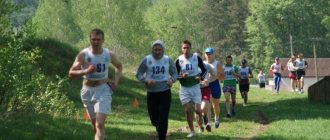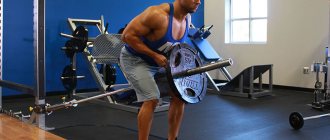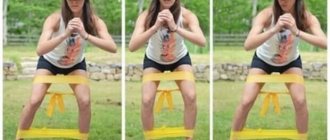Many people believe that trail running (or cross country) is more natural to the human body than running on asphalt. After all, while covering such a distance, the runner encounters many obstacles: stones, bumps, steep ascents and descents and other possible relief irregularities.
Therefore, this type of running is much more challenging, so your body is always in constant training during trail running.
What is trail running?
This type of running is very effective, it has a great effect on all our muscles, as well as the internal systems of the body. He's quite natural.
Cross-country running is significantly different from other types of running. When running on rough terrain, the muscles and joints do not work as intensely, since the legs are in contact with a softer surface (the ground) than asphalt. Professional athletes often run cross-country courses to relax their joints and restore their strength.
Trail running will help runners use a lot of muscles and keep their body in great shape, lean and toned. At the same time, the risk of injury, sprain and other stress, including on the joints, is minimal.
Benefits and features of crosses
Let's list the undeniable benefits of cross-country running:
- This type of running helps increase endurance, and also strengthens joints and ligaments and trains muscles. In addition, it is a healthy exercise for the cardiovascular system.
- This is an excellent energy drink for a person who is tired of constantly living in a stuffy and dusty city.
- This type of running is a great way to relieve stress and distract you from bad thoughts. Therefore, those who regularly run cross-country can count on a great mood.
- When running over rough terrain, the strength endurance of the body, as well as physical tone, increases very well.
- This type of running will help strengthen your muscle corset.
- Trail running improves self-discipline.
- Regular cross-country exercise will cause you to actively burn extra pounds. Your body will be significantly more toned and slimmer.
Professional approach
How to run 1 km without training? Follow these guidelines:
Read also: Features of Google Docs
- Back - make sure it is level.
- Feet - each new step occurs in such a way that the person touches the sole at the level of the center of gravity. Contact with the coating occurs using the rolling method: from heel to toe.
- Legs - the stride span should be maximum. So, they achieve the required acceleration using the laws of physics. At the base, the calf muscles act as springs. If you follow natural movements, you can easily select a running pace at which only horizontal acceleration is applied. The rest of the movements are carried out automatically.
- Hands - it is recommended to place them at an angle of 90 degrees, moving them only at the shoulder joint.
The body is slightly tilted before starting the movement. A person feels how he wants to move forward. After following each point, it is easy for even an inexperienced athlete to understand how to easily run 1 km without preparation.
How to start running cross-country?
Beginner runners need to know the rules that will allow them to achieve high results through training. In this type of running, the load should be increased gradually. But first, it’s generally better to walk at a pace and study the intended route.
During the first two to three months, it is recommended to choose an easy route, without steep ascents and descents, and increase the difficulty of the distance as you train. Cross-country is good to run along a forest path, or a flat area where there are small hills and descents.
When you get used to the loads and your muscle tone increases, you can begin training on a more difficult route.
A few words about jogging time. If it is enough for beginners to spend twenty minutes on cross-country, then as training progresses this time can be gradually increased, up to an hour and a half. You need to run cross-country at least twice a week. Only in this case will this training benefit you.
Tactics
When training, focus on cross-country speed training. Its essence is to accelerate in small segments along the distance, of which there should be more than 5. Cross-country training helps increase endurance. At competitions, this tactic of running 1 km will help you speed up as much as possible in the finals.
Since 1 km is an average running distance, it is important to learn how to distribute forces correctly. It is necessary to pick up the pace in the first 7-8 seconds of the run and approximately 200 meters before the finish. The rest of the distance is run at an average pace.
Attention! It is useful to include 10-15 sprint segments of 150-200 meters in training at a fast competitive pace.
Cross running technique
The technique of trail running is not much different from the paved path jogging you may be used to.
If you move in a straight line, then the technique is standard: keep your torso straight, arms slightly pressed to your body, maintaining a right angle. We first place the foot on the heel, then roll onto the toe.
It's another matter if you have ups and downs along the way.
Running uphill
To avoid overexertion, run with a slight bend in your body, take smaller steps, and actively move your arms.
During lifting, the greatest load falls on the feet and ankles.
It's not worth running a lot on the climb if your goal is just to be in good shape and not to prepare for competitions. It is enough to run uphill for less than half the distance.
Downhill run
During downhill running, the muscles in your knees and shins are actively used, so you should carefully calculate the load if you have injuries or other problems in these areas.
Also, people with excess body weight should be especially careful.
For prevention, you can wrap your knee with an elastic bandage. This way you can reduce the risk of injury by providing additional protection.
Breathing technique
How the runner breathes is very important during a cross-country race. You should inhale through your nose and exhale through your mouth. If you experience shortness of breath, you should switch to inhaling and exhaling exclusively through your mouth. If you can’t breathe like that, you should just slow down the pace.
If your pulse becomes too fast, you should walk or jog for some distance until your heart calms down. Then you can continue running at your usual pace.
Warnings
- Never despair and resist the strong urge to quit just because you know you won't be the winner of the race.
- At the start of the race, don't speed beyond 30 meters to death. You will only run out of steam in the first 500 meters.
- Don't eat or drink heavily in the hour before your race.
- Beware of being pinched at the beginning of the run! You have no idea how much can be lost here. To avoid this, push off like a sprinter immediately after the gun goes off and run almost 100% for 20-30 meters to get ahead of everyone; after which, return to your normal pace
- Always be aware of obstacles ranging from rivers, rocks, uneven ground to avoid spraining your ankle or worse...
Cross-country equipment
Shoes
Choosing the right shoes is very important for this type of running.
So, when running on a gravel path, you can prefer regular sneakers, but if you have rocky areas along the way, then shoes with durable and thick soles will do. This way you will protect your feet from hitting rocks.
Headdress
A hat is a mandatory attribute, which it is advisable to take with a visor - this way it will protect your eyes from the sun. Caps and baseball caps are quite suitable.
Cloth
Sportswear for a runner should:
- match the season
- not too tight, but also not loose on the body,
- be comfortable, do not rub.
- In rainy weather, you should take a windbreaker or raincoat with you.
- In addition, you should take care of protection for your knees and elbows.
Federation
Athletics has its own federations that organize and conduct competitions in this discipline.
International Association of Athletics Federation
The International Association of Athletics Federation (IAAF) is the world governing body for the sport of athletics, founded on 17 July 1912. It consists of 212 countries, divided into six continental associations.
The main goal of the Federation is to promote athletics so that everyone can engage in it, regardless of their gender, race, political and religious views, etc. The IAAF also monitors the performance of duties by the national federations that are part of it; participates in the fight against doping, takes responsibility for organizing competitions at the Olympic Games.
European Athletic Association
In November 1969, the Association of European Members of the IAAF was formed in Bucharest. The following year, her constitutional rights were approved.
The European Athletic Association (EAA) is one of the six continental associations that make up the IAAF. She runs athletics in Europe. Its members are 51 national associations.
All-Russian Athletics Federation
The All-Russian Athletics Federation is part of the European Athletic Association and manages athletics competitions in Russia. It was founded on June 8, 1990. ARAF was created with the aim of spreading athletics as one of the sports in Russia and preparing sports teams to perform in international competitions.
Reviews from runners about trail running
This is a wonderful type of running, I love it very much. Every time I come to a village or country house, I run cross-country. The only bad thing is that it’s difficult to measure the distance you’ve covered. I therefore focus on time, as well as my own feelings. Grade:
Andrey
You can track your mileage using various smartphone apps. I really like running cross-country – fresh air, beautiful scenery. I'm always in a good mood after running. Grade:
Galina
In the summer I run cross-country at the dacha. Running along a forest path is a pleasure. Then I turn into the meadow, here, of course, a hat is required so that the sun doesn’t bake your head... Rating:
Maksim
My favorite type of running! Fresh air, beautiful scenery around. And the muscles are always toned after such runs. I try to run every weekend to stay in shape. And on weekdays I work out in the gym, on the treadmill. Grade:
Olga
I’ve been running cross-country since school, I’m used to it, it’s become my tradition. I try to run 2-3 times a day, with rare exceptions. I alternate between ups and downs. Great for helping prepare for various competitions. Plus, you’re always in a great mood after a workout. Grade:
Alexei
PHASE I[edit
In general, I strongly recommend that cross-country athletes do a longer initial phase of steady, easy running. Experienced runners are very familiar with this phase and usually have a good feel for how much time they should devote to this type of training early in the season. Beginning runners should do light running for at least four weeks. It would be great if you could devote more time to this, but school and university programs, unfortunately, often do not allow this. In many cases, school and student coaches receive a batch of completely raw recruits every year, with very limited time to build the foundation of their preparation before the start of competition. Students and schoolchildren should be asked to do fundamental work during the summer holidays. Whenever possible, this work should be done on dirt roads, clay soil and grass to prepare for anything that may be encountered on the cross-country course.
All running during this phase should be only light (L), but it should be supplemented with exercises and stretches every day. Increase your weekly mileage by 10,000-15,000 meters every third week (or 40-60 minutes). New runners should start with no more than 30 minutes of easy running, broken up into 2-5 minute chunks and separated by a few minutes of walking for recovery. L-running should be practiced for at least three weeks until the athlete can run continuously for 30 minutes. More experienced runners and beginners with more than four weeks of Phase I can try gradually increasing their weekly mileage to two-thirds of their maximum weekly mileage goal for the season.
Competition rules
Cross-country races are held all over the world, so due to the different natural conditions and competition locations, it is difficult to standardize the rules for this discipline. Nevertheless, there is a certain set of regulations that should be followed during the organization and during the competition.
Venue of the competition
The competition season opens in winter. The venue for the race must be large enough to accommodate the track and necessary equipment. In order to make it interesting for the public to watch what is happening, the track is placed in a wooded area where participants will have to face natural obstacles.
At all major competitions, and if possible, at any others, several rules must be followed:
Also, special attention should be paid to fencing the competition area.
Route requirements
There are separate requirements for the route:
To make the route seem natural, it is necessary to use alternating ascents, descents and short straight sections.
Start
The shot of the pistol means the start of the race. At international competitions, warnings about the start are given 5 minutes, 3 minutes and 1 minute before. Care must be taken to ensure that water and food are provided to competitors in the start and finish areas at all competitions. If weather conditions allow you to equip drinking and refreshment points at each circle, then this should be done.
What should be the approximate body angle for a high launch?
At the command “Start!” the runner takes the starting position, in which the pushing (strongest) leg is at the line, and the swing leg is placed 2–2.5 feet behind. The angle of inclination of the body is approximately 40-45°, the legs are bent at the hip and knee joints, the GCMT (general center of mass of the body) is located closer to the supporting leg.
Interesting materials:
How to clean soap stains in the bathroom? How to clean a glass shower stall? How to remove touch up concealer from clothes? How is barley useful? What does a duck bird eat? What do geese eat? How to feed apricots after harvest? How to feed quince? How to feed a lemon so that it bears fruit? How to feed tomatoes in the greenhouse after planting?
Workout
To know how to properly run 1 km without preparation, daily exercises are carried out to develop the following skills:
- Correct foot placement occurs while running barefoot or when training on a scooter.
- Activation of the gluteal muscles is carried out during daily training by running a short distance.
- Developing the correct body position occurs during the exercise: running in place while fixing the waist with a tourniquet. A man tries to stretch a rope tied to a stationary object: a fence, a peg.
- The springing properties of the lower parts of the legs are developed during exercises with a skipping rope.
- The skill of maintaining a balance of strength and a sense of rhythm is acquired by running with a skipping rope. A person gets used to removing his foot from the covering in time and putting it back in place.
No champion would achieve high results without daily training. Only diligence helps you acquire the missing skills in a short time.
Historical reference
Perhaps everyone knows what cross-country shoes and sneakers are. But not everyone is aware that cross-country running originated in Great Britain in the 19th century. from an ordinary children's game of catch. The first tournament also took place there, for which one of the parks in Wimbledon was allocated. The race had a very extreme nature - participants jumped over fences, crossed streams and shallow rivers, and made their way through bushes.
Modern cross country is significantly different from what existed in the past. It is still very popular in England and is part of the compulsory school curriculum. Cross-country competitions are organized annually at the national level, the winners of which represent the country on the international stage.
This type of running has gained recognition not only in England, but also in Russia. Every domestic schoolchild knows what it means to run cross-country. Competitive races are also held and are a very spectacular event, and any modern athlete, regardless of what sport he is involved in, must have participated in cross-country.











